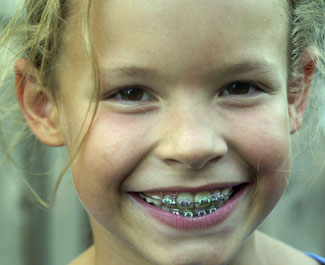When you have braces, you’ll need to take extra care of your teeth, as well as your new appliances. Here’s a list of things that will make your orthodontic experience more convenient, more comfortable, and more efficient.
- A good orthodontist-recommended toothbrush. Whether you use a manual or an electric toothbrush, be sure to choose one with soft bristles. Brush in a gentle, circular motion to massage and clean your teeth and gums, and remove any food particles stuck between your wires and brackets.
- Non-whitening toothpaste. If you use whitening toothpaste, your teeth may not whiten evenly, because the tooth surface bonded to the brackets will not be exposed to the whitening agent. Save your teeth-whitening treatment for when your braces are removed, and all teeth can be whitened evenly and at the same time.
- A water flosser. Flossing between each bracket and wire is essential to keep your teeth healthy and your appliances intact, but it’s not easy. Try using a water flosser, such as Waterpik® or Sonicare®, which uses a stream of pressurized water to remove plaque and debris.
- Orthodontic floss and floss threaders. If a water flosser isn’t feasible, buy floss specifically made to be used with braces. Similar to traditional floss, orthodontic floss is threaded between your teeth to remove plaque and food particles. However, orthodontic floss has a sturdy tip which makes it easier to thread under your wires.
- Mouthwash. Cavities and gum disease can delay the outcome of your orthodontic treatment and damage your smile. An antiseptic and anti-plaque mouthwash kills plaque bacteria that can lead to cavities, gingivitis, and bad breath. Mouthwash with fluoride also helps strengthen enamel and protects against tooth decay.
- Pain relievers. When your braces are placed, and after each adjustment, you may experience soreness and discomfort. While this is perfectly normal and temporary, you can use an over-the-counter pain reliever, such as Tylenol (Acetaminophen), as directed to ease your discomfort.
- Soft foods. There are some foods you’ll have to avoid when you have braces. These include foods that are chewy (for example, licorice), crunchy (popcorn), sticky (caramel), and hard (nuts). To prevent damage to your braces, stick to soft foods like cheese, pudding, pancakes, mashed potatoes, steamed vegetables, applesauce, and bananas.
- Wax. Your lips, cheeks, and tongue may become irritated for one to two weeks as they become used to the braces. We would be happy to give you some wax you can put over the braces to lessen the tenderness. If you need some wax, please let us know.
Questions about what you’ll need during your orthodontic treatment? Just contact our office and ask! We’re here to make sure your time in braces is as pleasant and comfortable as possible.
- See more at: http://www.sesamecommunications.com/ppnarticles/checklist-for-your-life-with-braces/#sthash.yBIMRKbw.dpuf












 Website Powered by Sesame 24-7™
Website Powered by Sesame 24-7™